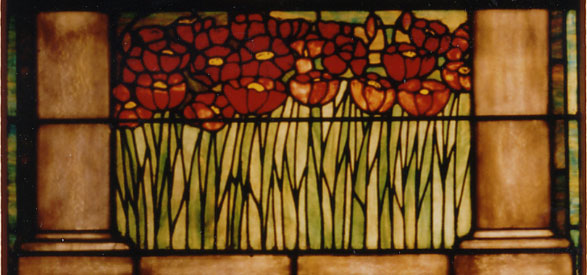
Ask Geoff
By Geoff Williams, University Archivist
Have you ever looked closely at the walls of UAlbany’s downtown campus?
Or are they just backdrops for studying or for moving from one room or building to another?
For me, until very recently, much of the art has been backdrop. I have given guided tours for alumni classes and outside groups of the historical art on the downtown campus for many years, and I thought it might be interesting to let a wider audience know about the downtown art – and to take a closer look at it myself.
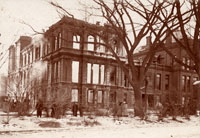
The classical stained-glass window below was lost in 1906 when the Willett Street Building burned. The building is pictured above after the fire.
In researching this article, I came to realize that the art collections there are much more varied than I thought they were. There are two types of art representing two different periods of the University’s history. The first, created from 1910 through the 1940s, is very traditional and celebrates classical, historical or literary themes. All of the early 20th-century art was purchased with funds from alumni or graduating classes, and most of it has been restored by alumni. The second, 81 items in all – far more than I had imagined – is art from the University’s contemporary art collections, most installed during the last 10 years and representing student art works, and/or art given to or loaned to the University. These pieces represent a conscious effort by the University Art Museum to display works that would ordinarily be stored.
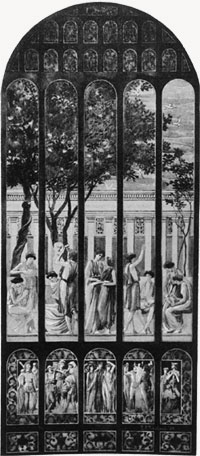
Our earliest collections of art date from the construction of the Willett Street building in the 1880s. A prominent feature of that building was a massive stained-glass window depicting classical Greek and Roman themes related to education, and reputed to be the largest such window in the United States at the time. Located in the Assembly Hall of the State Normal School, which became the State Normal College in 1890, the window was paid for by the Alumni Association, designed by Ezra Treadwell of Boston, and possibly completed by Tiffany & Co. Unfortunately, no color image of it exists. When the Willett Street building burned in 1906, the Alumni Window was completely destroyed, along with oil paintings of the school’s early leaders. The only item saved from the fire was the plaster statue of Minerva, the Roman goddess of wisdom and UAlbany’s symbol. (For more about Minerva, please see “Ask Geoff” in the Fall 2007 UAlbany, which is available online.)
Graduating classes soon decided that a stained-glass window for the new auditorium – the first floor of what is now Hawley Hall, or the Dewey Library – would be an ideal gift to the school. From 1910 through 1926, graduating classes and student groups from the State Normal College, and after 1914, the New York State College for Teachers, donated funds to install in the auditorium stained-glass windows portraying classical Greek or Roman themes, and occasionally historical themes tied to the immediate past. The latter included the Class of 1920 gift, a window depicting the World War I cemetery at Flanders Field in Belgium, and the 1926 Spanish Club’s gift memorializing Francesca Martinez, a beloved French and Spanish teacher who died in 1925. Between 1980 and 1986, the Hawley windows were restored by the Chapman Studio in Albany, which is credited with designing many of the windows originally. The classes of 1927, 1928, 1929, 1930, 1931, 1932, 1933, 1934 and 1952 paid for the restorations.
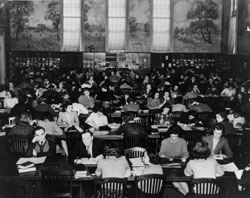
In this 1940 shot of Hawley Library, several murals are partially visible.
Not to be outdone by State College for Teachers classes, Milne High School students embarked on their own campaign to beautify Milne Hall, which opened in1929. They raised funds to reproduce the 115-foot-long by 11-inch-high frieze of “Alexander the Great’s Entrance into Babylon” around the top of the library in Milne 200. The frieze was copied from the one created for the Quirinal Palace in Rome by the Danish sculptor Bertel Thorvaldsen and commissioned by Napoleon in 1815 to celebrate his conquest of Italy.

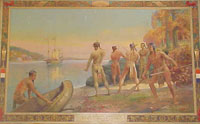
Milne School students raised funds for a frieze depicting "Alexander the Great's Entrance into Babylon," top, and a mural portraying the arrival of Henry Hudson's Half Moon in Albany, bottom.
Milne students also decorated the walls of their library with the first murals on the downtown campus. During the early 1930s and ’40s, at the suggestion of Milne School Principal John Sayles, the students commissioned Albany artist David Lithgow to create murals representing the Leather Stocking Tales and the histories of Albany and the State College for Teachers. Others depict Albany as a trading post, the Anti-Rent riots of 1838, the Anti-Ratification riots of 1788, Governor Dongan signing the Albany Charter, the courtship of Alexander Hamilton and Elizabeth Schuyler, and the state office building near the Capitol, to name a few. The Lithgow series was incomplete, however; the planned mural of the Albany skyline on the north wall was never painted.
All of the Milne 200 murals have just been restored by Milne alumni. These and other images of the murals and friezes can be seen online.
An even larger set of murals graces Hawley Hall. In 1932, then-Gov. Franklin Roosevelt approved funds to transform the Hawley auditorium into a library for the State College for Teachers. Later, as president during the Depression, Roosevelt supported hiring artists with federal funds to create art in public spaces – and, for the first time, art on the downtown campus was not paid for by students or graduates.
In the next “Ask Geoff,” I’ll continue our look at the downtown campus as art gallery and provide an itinerary for a self-guided tour.
- UAlbany Magazine
Fall 2011 - Cover Story
- Features
- Departments
- The Carillon
- Past Issues
-
More ways to read UAlbany online
Download PDF





